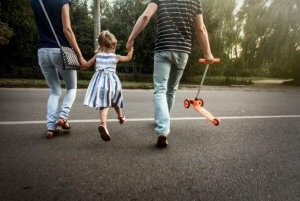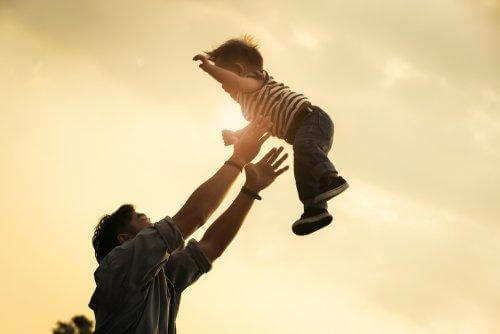Painful Pronation of the Elbow in Children: What to Do?

Painful pronation or nursemaid’s elbow is a slight subluxation or partial dislocation of a bone in the elbow joint. It tends to happen because of a quick pull on the arm of a child.
For this reason, we’re going to tell you everything you need to know about painful pronation in children. Take note!
Painful pronation in children
Painful pronation is a common injury in small children that can occur from around the age when they learn to walk (approx. 15 months old) until about 5 years old. In general, children will get painful pronation from a strong pull of the bones in the forearm.
Usually, this injury is the result of an adult holding the child’s hand while they try to get away. It’s unusual that children over the age of 5 suffer from this injury, as their joints are much stronger.
On the other hand, you should know that a fall is the second most common cause of this kind of injury. Basically, it’s a condition caused by pulling the forearm of your child while his arms are extended.
Consequently, a slight dislocation of the elbow bone can occur and prevent your child from bending his arm completely. After a pulling trauma to this hinge joint, the head of the radial bone dislocates. The result is that any movement is painful in the affected limb.
Likewise, you should know that there seems to be a greater tendency for the injury to involve the left arm. This is probably because most caregivers are right-handed.
As a consequence of the pain, the child will begin to cry and she’ll refuse to move her arm. She’ll keep her arm immobile and close to her body, perhaps supporting the forearm on the abdomen with a slight bend in the elbow.
Once the child has been examined, the nurse or doctor will put the elbow back in place again. This injury doesn’t cause any long-term effects for the child.

What are the symptoms?
Normally the ligaments keep the radial bone in place, but a sudden fall or pull may stretch the ligament to excess. This will cause the bone to slide partially out of the ligament. In most cases, children with painful pronation of the elbow cry immediately after the pull. It’s also likely they won’t want to use the affected arm at all.
Therefore, if you believe your child has suffered painful pronation, you should look for immediate medical treatment. You could see the doctor on call, for example, or visit the emergency department of a hospital.
Don’t forget that the more time the bone stays out of place, the more painful and difficult it will be to realign the bones. It will also take your child longer to recover completely.
Unfortunately, the procedure to relocate the arm bones in the joint is painful and distressing, but it lasts just a brief moment. After the doctor works to relocate the bones of the joint, the radial bone settles back in place.
If for some reason it’s difficult to relocate the elbow back in its place, or your child is still not using the injured arm, you should have an X-ray taken. This will check if there are possibly other injuries because it could also be a fracture.
What kind of precautions should families take at home?
Once the medical professionals treat the pronation of the elbow, the child should be able to resume normal activities. Nonetheless, if the elbow remains partially dislocated for a long time, it’s possible that the child needs to take analgesics for one or two days.
You should follow the recommendations given to you by the nurse or doctor to gradually relieve the pain.
If your child still hasn’t regained full use of his arm the following day, you should return to the doctor. The medical professionals will reevaluate the arm. Remember the injury will have no long-term effects on the child if medical professionals treat it quickly and appropriately.

To avoid painful pronation in children, you should be careful not to lift your child by the lower arms or the wrists. Rather, the best way to lift a child is from the armpits. It’s recommended you teach the correct form to pick up and carry your child to the other people who care for him regularly.
Finally, we remind you that some children have a greater propensity to suffer from a pulled elbow. It can even happen more than once. A pulled elbow can recur several times in children who have joints that are particularly loose.
Taking into consideration this article, you shouldn’t worry excessively if your child presents with this injury. The ideal response is to take the child for prompt medical attention when they have this kind of injury.
Painful pronation or nursemaid’s elbow is a slight subluxation or partial dislocation of a bone in the elbow joint. It tends to happen because of a quick pull on the arm of a child.
For this reason, we’re going to tell you everything you need to know about painful pronation in children. Take note!
Painful pronation in children
Painful pronation is a common injury in small children that can occur from around the age when they learn to walk (approx. 15 months old) until about 5 years old. In general, children will get painful pronation from a strong pull of the bones in the forearm.
Usually, this injury is the result of an adult holding the child’s hand while they try to get away. It’s unusual that children over the age of 5 suffer from this injury, as their joints are much stronger.
On the other hand, you should know that a fall is the second most common cause of this kind of injury. Basically, it’s a condition caused by pulling the forearm of your child while his arms are extended.
Consequently, a slight dislocation of the elbow bone can occur and prevent your child from bending his arm completely. After a pulling trauma to this hinge joint, the head of the radial bone dislocates. The result is that any movement is painful in the affected limb.
Likewise, you should know that there seems to be a greater tendency for the injury to involve the left arm. This is probably because most caregivers are right-handed.
As a consequence of the pain, the child will begin to cry and she’ll refuse to move her arm. She’ll keep her arm immobile and close to her body, perhaps supporting the forearm on the abdomen with a slight bend in the elbow.
Once the child has been examined, the nurse or doctor will put the elbow back in place again. This injury doesn’t cause any long-term effects for the child.

What are the symptoms?
Normally the ligaments keep the radial bone in place, but a sudden fall or pull may stretch the ligament to excess. This will cause the bone to slide partially out of the ligament. In most cases, children with painful pronation of the elbow cry immediately after the pull. It’s also likely they won’t want to use the affected arm at all.
Therefore, if you believe your child has suffered painful pronation, you should look for immediate medical treatment. You could see the doctor on call, for example, or visit the emergency department of a hospital.
Don’t forget that the more time the bone stays out of place, the more painful and difficult it will be to realign the bones. It will also take your child longer to recover completely.
Unfortunately, the procedure to relocate the arm bones in the joint is painful and distressing, but it lasts just a brief moment. After the doctor works to relocate the bones of the joint, the radial bone settles back in place.
If for some reason it’s difficult to relocate the elbow back in its place, or your child is still not using the injured arm, you should have an X-ray taken. This will check if there are possibly other injuries because it could also be a fracture.
What kind of precautions should families take at home?
Once the medical professionals treat the pronation of the elbow, the child should be able to resume normal activities. Nonetheless, if the elbow remains partially dislocated for a long time, it’s possible that the child needs to take analgesics for one or two days.
You should follow the recommendations given to you by the nurse or doctor to gradually relieve the pain.
If your child still hasn’t regained full use of his arm the following day, you should return to the doctor. The medical professionals will reevaluate the arm. Remember the injury will have no long-term effects on the child if medical professionals treat it quickly and appropriately.

To avoid painful pronation in children, you should be careful not to lift your child by the lower arms or the wrists. Rather, the best way to lift a child is from the armpits. It’s recommended you teach the correct form to pick up and carry your child to the other people who care for him regularly.
Finally, we remind you that some children have a greater propensity to suffer from a pulled elbow. It can even happen more than once. A pulled elbow can recur several times in children who have joints that are particularly loose.
Taking into consideration this article, you shouldn’t worry excessively if your child presents with this injury. The ideal response is to take the child for prompt medical attention when they have this kind of injury.
All cited sources were thoroughly reviewed by our team to ensure their quality, reliability, currency, and validity. The bibliography of this article was considered reliable and of academic or scientific accuracy.
- Krul, M., van der Wouden, J. C., van Suijlekom-Smit, L. W., & Koes, B. W. (2012). Manipulative interventions for reducing pulled elbow in young children. In M. Krul (Ed.), Cochrane Database of Systematic Reviews. Chichester, UK: John Wiley & Sons, Ltd. https://doi.org/10.1002/14651858.CD007759
- Aylor, M., Anderson, J. M., Vanderford, P., Halsey, M., Lai, S., & Braner, D. A. V. (2014). Reduction of Pulled Elbow. New England Journal of Medicine, 371(21), e32. https://doi.org/10.1056/NEJMvcm1211809
- McCormack, M. P. (1959, May 9). Pulled Elbow. British Medical Journal. https://doi.org/10.1136/bmj.1.5131.1240-b
This text is provided for informational purposes only and does not replace consultation with a professional. If in doubt, consult your specialist.








